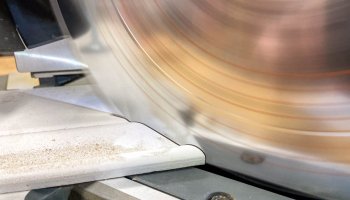
Thinking about a job in construction? Understanding how to use a miter saw for trim work gives you a leg up on one of the most basic job site skills. A miter saw works best for trim projects requiring accurate straight, beveled, and/or mitered cuts.
In its simplest form, the miter saw makes angled or mitered cuts across the face of a board. The most popular Pro models include sliding rails to increase the maximum width of the cut. That translates into the ability to cut wider boards.
More expensive saws also allow for beveling to both sides. Finally, extendible fences and miter saw stands can aid in supporting longer boards.
In continuing our Training the Apprentice series, we want to ensure you understand how to best use a miter saw for trim work. We also want you to know when to use this particular tool.
A Brief Overview of Miter Saw Types
We wrote a thorough piece on understanding the types of miter saws, but here’s a quick breakdown to distinguish between various configurations.
- Miter Saw: Has a mitering table that adjusts the cross-cut angle
- Sliding Miter Saw: Has a rail system that slides the blade from front to back and extends the maximum cutting width
- Compound Miter Saw: Has an adjustment left and/or right to cut through the wood at a beveled angle
- Compound Sliding Miter Saw: Gives you mitering, beveling, and sliding functions
- Dual Compound Sliding Miter Saw: Gives you all three functions with beveling to both left and right. This avoids having to flip the piece around when making bevels in both directions.
Note: Check out our best miter saw reviews buying guide as well.
When to Use a Miter Saw
The first rule might be—don’t use this tool unless you have to. A miter saw works best for trim carpentry. Above all else, this is a finishing tool. If you find yourself needing to cut 2x material on a framing project—a sidewinder or worm drive may be the better choice.
We’ve seen apprentices wheel these off the backs of trucks only to have them sit around the jobsite unused. A circular saw takes care of most cross- and angled-cuts. Why use a big heavy machine and lift heavy boards when you don’t have to? For 2X material—just grab a framing square and complete the cut right where the material sits.
If, however, you need one of these tools—then by all means continue reading. Hopefully, we can help you understand how to use them in a way that helps your workflow.
How to Use a Miter Saw
Safety First
Before we teach you how to use a miter saw, we feel the need to remind you about safety. Follow these safety tips and keep yourself safe:
- Always wear eye protection—no exceptions!
- Avoid loose clothing and jewelry that can catch on the blade
- Mind where your hands are at all times (most saws include a warning on them to keep your hands a specific distance from the blade)

Here are a few additional PPE considerations, depending on the material you’re cutting:
- Gloves
- Dust mask
- Ear protection
- Dust collection
You have a powerful motor spinning a sharp blade. Be sure to maintain a healthy respect for the tool. Using these saws can get really dangerous if you lose focus.
Get to Know Your Miter Saw
Before you start making those first cuts, familiarize yourself with the tool. Flip through the instruction manual (if you can find it). Learn the location of all the locks and adjustments. Each miter saw differs from the next, and even our most seasoned Pros familiarize themselves with the controls before getting started.
Miter vs Bevel vs Compound Cuts
If needed, check out our article on bevel vs miter cuts. That covers the differences between making bevel, miter, and compound cuts. This article presumes you already know the difference. As an apprentice, you don’t want to mix these up!
Calibrate Your Saw
If you open the box to a perfectly calibrated miter saw, you might want to try your luck in the lottery. Most of these tools need at least small tweaks before you put them to use. Check out our guide on how to calibrate a miter saw to walk you through what to check.
Set Your Miter Angle
To make a basic miter cut, unlock the miter gauge and slide it to the angle you need. Most saws let you miter in both directions, so just double-check the cutting angle before spinning up the blade.
Most saws also have detents at common angles on the miter gauge. These automatically lock the saw into place. Typically, detents occur at 0°, 22.5° 31.6°, and 45°. You might find some variations from one saw to the next. If you need a different angle, just slide the arrow to the angle needed and lock down the table to keep it from moving during the cut.
Set Your Bevel Angle
When making a bevel cut, leave the miter gauge at 0° and unlock the bevel gauge. Most saws have detents to help set common angles. Most commonly, those exist at 0°, 33.9°, and 45°, but your saw may have additional stops. Like the miter gauge, you can use the lock to set custom angles in between the detents.
If you have a dual bevel miter saw, a release typically unlocks the right-side bevel. Your owner’s manual will help you find it quickly, or you can be like David C. Smith and spend an hour reveling in your pride.
Setting a Compound Angle
The need for cutting compound angles arises when installing crown molding among other applications. It’s a relatively simple process of setting both a miter angle and bevel angle. Knowing what those angles are, however, is a different story. Many websites exist to help you figure those out. Also, some saws include a guide right on the tool.
Make the Cut
If your miter saw doesn’t slide, making your cut is simple. Let the saw spin up. Drop the blade to meet the wood. Then, while letting the saw maintain a high RPM, continue lowering the blade until you complete the cut.

When using the extra capacity of a sliding miter, pull the blade out towards you and start your cut at the front. Then push the blade through, allowing it to maintain high RPMs.
Once you complete the cut, let the blade come to a complete stop before letting it rise back to its resting position. Some of these tools include a blade brake that stops the blade very quickly.
Dust collection on a miter saw is far from phenomenal, but some are better than others. In a shop, do yourself a favor and connect a dust extractor or your best shop vacuum to contain the mess. Bags work as a stopgap if you don’t have or want to use a vacuum. Work outside and you can often get away with skipping both. Just check the wind direction!

If you have any additional Pro tips you’d like to add, feel free to leave them in the comments section below.






